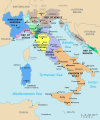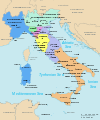
Unification of Italy
The unification of Italy (Italian: Unità d'Italia, Italian: [uniˈta ddiˈtaːlja]), also known as the Risorgimento (/rɪˌsɔːrdʒɪˈmɛntoʊ/, Italian: [risordʒiˈmento]; lit. 'Resurgence'), was the 19th-century political and social movement that resulted in 1861 in the consolidation of various states of the Italian Peninsula and its outlying isles into a single state, the Kingdom of Italy. Inspired by the rebellions in the 1820s and 1830s against the outcome of the Congress of Vienna, the unification process was precipitated by the Revolutions of 1848, and reached completion in 1871 after the capture of Rome and its designation as the capital of the Kingdom of Italy.[1][2]
This article is about the 19th century consolidation of Italian states into a single state. For the Roman unification of the Italian Peninsula, see Roman expansion in Italy.Native name
Risorgimento
1848–1871
- Proclamation of the Kingdom of Italy
- Capture of Rome
- Rome becomes the capital of the Kingdom of Italy
Even after 1871, many ethnic Italian-speakers (such as Trentino-Alto Adigan Italians, Istrian Italians, and Dalmatian Italians) remained outside the borders of the Kingdom of Italy, planting the seeds of Italian irredentism. Individuals who played a major part in the struggle for unification and liberation from foreign domination included King Victor Emmanuel II of Italy, Camillo Benso, Count of Cavour, Giuseppe Garibaldi, and Giuseppe Mazzini.[3]
Some of the states that had been envisaged as part of the unification process (terre irredente) did not join the Kingdom until after Italy defeated Austria-Hungary in the First World War, culminating in the Treaty of Rapallo in 1920. Some historians see the Risorgimento as continuing to that time, which is the view presented at the Central Museum of the Risorgimento at Altare della Patria in Rome.[4][5]
Background[edit]
From ancient times to early modern era[edit]
Italy was unified by the Roman Republic in the latter part of the third century BC. For 700 years, it was a de facto territorial extension of the capital of the Roman Republic and Empire, and for a long time experienced a privileged status but was not converted into a province. Under Augustus, the previous differences in municipal and political rights were abolished and Roman Italy was subdivided into administrative regions ruled directly by the Roman Senate.
After the fall of the Western Roman Empire, Italy remained united under the Ostrogothic Kingdom and after 568 was disputed between the Kingdom of the Lombards and the Byzantine (Eastern Roman) Empire, losing its unity for centuries. Following conquest by the Frankish Empire, the title of King of Italy merged with the office of Holy Roman Emperor; however, the emperor was an absentee German-speaking foreigner who had little interest in governing Italy and indeed never controlled the entire peninsula. As a result, Italy gradually developed into a system of city-states. Southern Italy was governed by the long-lasting Kingdom of Sicily or Kingdom of Naples, which had been established by the Normans. Central Italy was governed by the Pope as a temporal kingdom known as the Papal States.
This situation persisted through the Renaissance but began to deteriorate with the rise of modern nation-states in the early modern period. Italy, including the Papal States, then became the site of proxy wars between the major powers, notably the Holy Roman Empire (including Austria), Spain, and France. Harbingers of national unity appeared in the treaty of the Italic League, in 1454, and the 15th-century foreign policy of Cosimo de' Medici and Lorenzo de' Medici. Leading Renaissance Italian writers Dante, Petrarch, Boccaccio, Machiavelli and Guicciardini expressed opposition to foreign domination. Petrarch stated that the "ancient valour in Italian hearts is not yet dead" in Italia Mia. Machiavelli later quoted four verses from Italia Mia in The Prince, which looked forward to a political leader who would unite Italy "to free her from the barbarians".[6]
The Italian Wars saw 65 years of French attacks on some of the Italian states, starting with Charles VIII's invasion of Naples in 1494. However, the Peace of Cateau-Cambrésis (1559) saw parts of Italy fall under the direct or indirect control of the Spanish Habsburgs. The Peace of Westphalia in 1648 formally ended the rule of the Holy Roman Emperors in Italy. However, the Spanish branch of the House of Habsburg, which ruled the Spanish Empire, continued to rule Southern Italy and the Duchy of Milan until the War of the Spanish Succession (1701–14). Following this war the Austrian Habsburgs struggled for dominance with the Spanish Bourbons until the end of the War of the Austrian Succession.
A sense of Italian national identity was reflected in Gian Rinaldo Carli's Della Patria degli Italiani,[7] written in 1764. It told how a stranger entered a café in Milan and puzzled its occupants by saying that he was neither a foreigner nor a Milanese. "'Then what are you?' they asked. 'I am an Italian,' he explained."[8]
Early revolutionary activity[edit]
Exiles and European and masculine ideals[edit]
Many of the key intellectual and political leaders operated from exile; most Risorgimento patriots lived and published their work abroad after successive failed revolutions. Exile became a central theme of the foundational legacy of the Risorgimento as the narrative of the Italian nation fighting for independence.[33] The exiles were deeply immersed in European ideas, and often hammered away at what Europeans saw as Italian vices, especially effeminacy and indolence. These negative stereotypes emerged from Enlightenment notions of national character that stressed the influence of the environment and history on a people's moral predisposition. Italian exiles both challenged and embraced the stereotypes and typically presented gendered interpretations of Italy's political "degeneration". They called for a masculine response to feminine weaknesses as the basis of national regeneration and fashioned their image of the future Italian nation firmly in the standards of European nationalism.[34]







